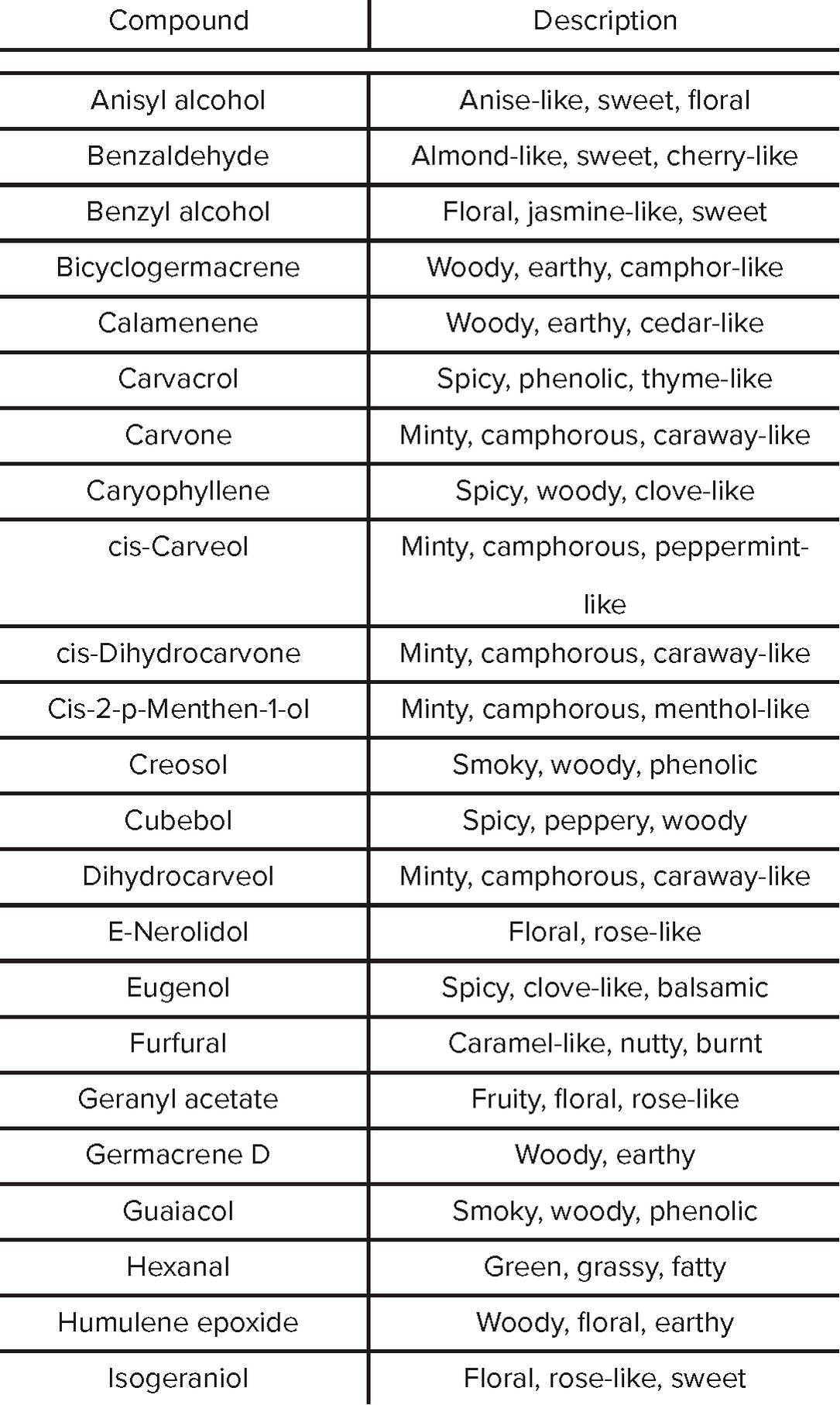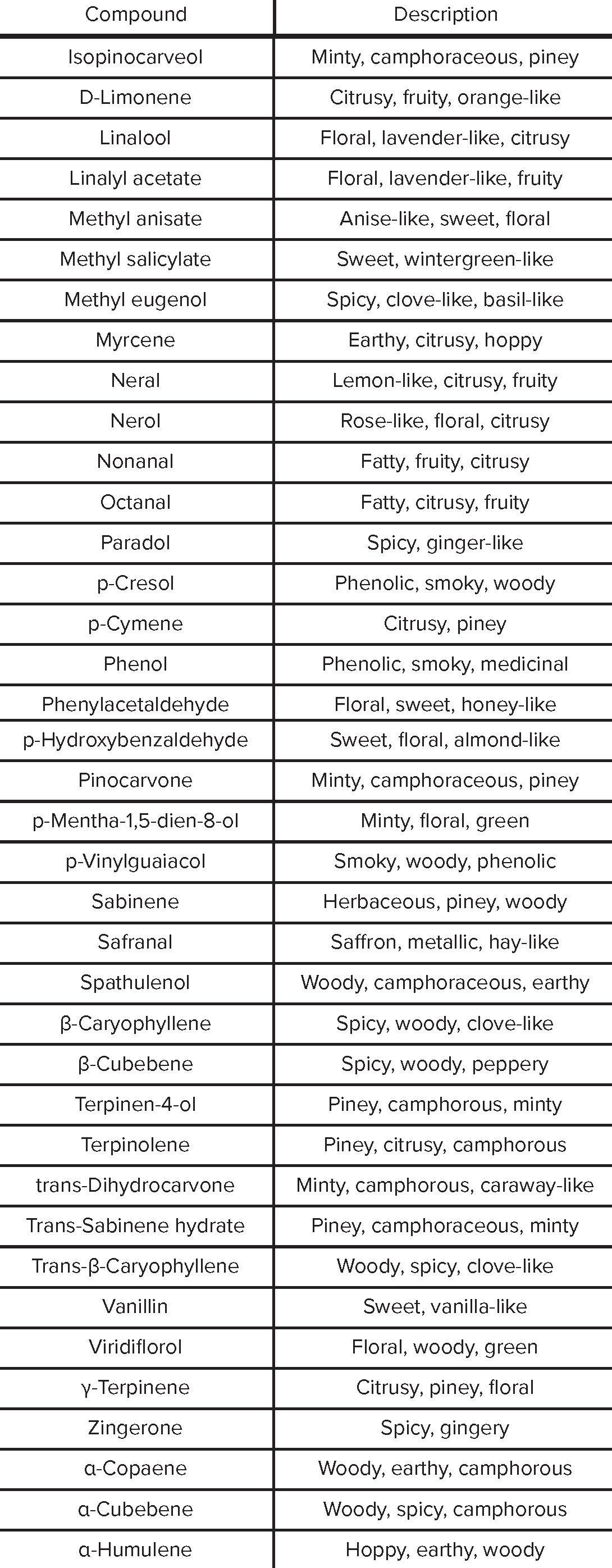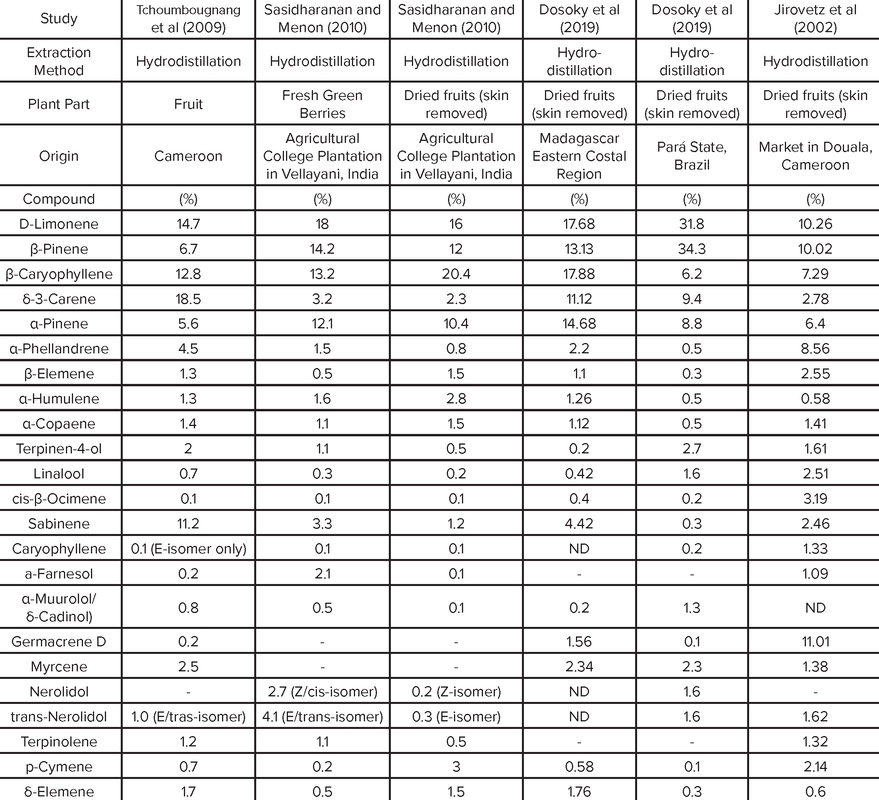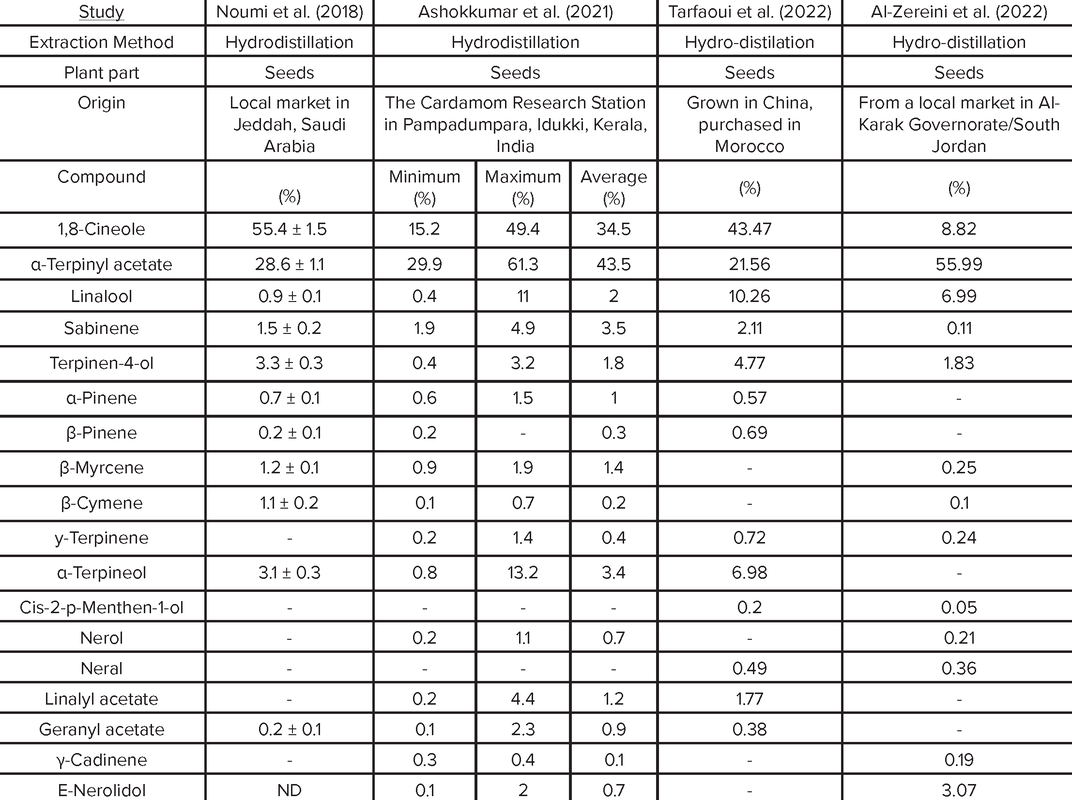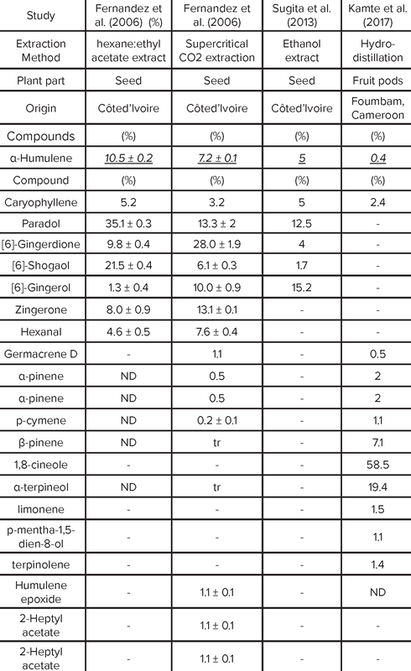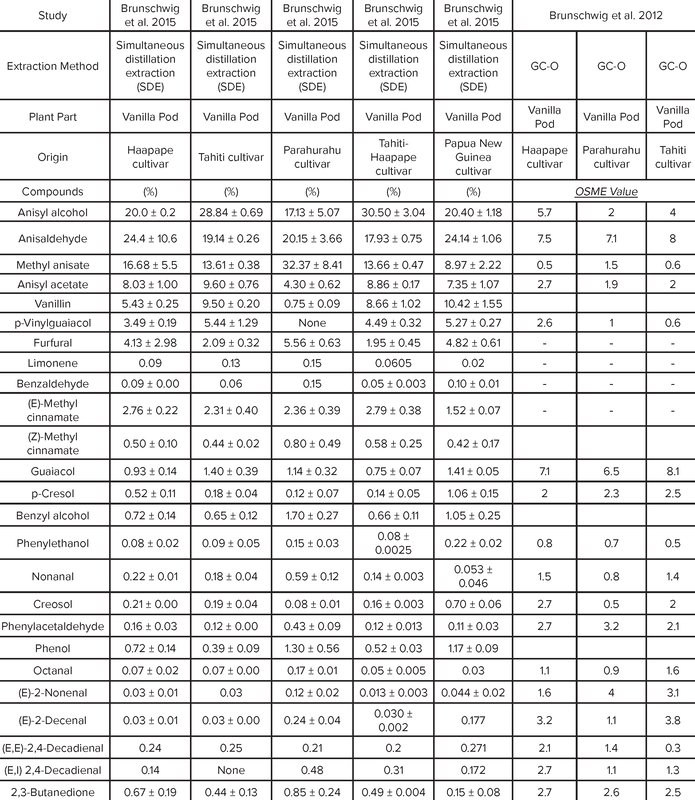Spice Aroma Compounds:
Part 2
By: Brent Nakano
Spices are seeds, fruits, roots, bark, or other plant substances primarily used for flavoring or coloring food. Spices can be added to most cocktail styles by using bitters, integrating them into a syrup like orgeat or grenadine, or adding a spice driven liqueur. The component of spices that proves flavor are the spices’ essential oils, which are composed of aromatic compounds. As noted in the July 2023 issue in the article entitled “A Guide to Cocktail Recipe Development”,(https://www.hawaiibevguide.com/a-guide-t-flavor-pairings-and-recipe-development) recipes can be developed through:
This issue is a continuation of last month and covers
- Food pairing: Flavors are intensified by mixing ingredients with similar chemical compounds.
- Food bridging: Two ingredients that do not share a strong molecular or empirical affinity are bridged through another ingredient or a path of non-repeating ingredients within a network of ingredient affinities
- The avoidance of food-bridging and food-pairing
This issue is a continuation of last month and covers
- Piper species (spp.) of Black and white pepper, Cubeb and Ashanti Pepper
- Cardamom and Large Cardamom
- Caraway
- Grains of Paradise
- Vanilla species of Madagascar Vanilla and Tahitian Vanilla
How to use the following charts
The charts provide generalizations about the relative percentage of aromatic compounds that exist in common spices as found by Gas Chromatography Mass Spectrometry (GC-MS), Gas Chromatography Olfactory (GC-O) or the analytical method listed. This approach was taken because of the common variations in aroma compounds attributed to differences like environmental factors, plant varieties, cultivation practices, harvesting stage, method of storage and method of extraction. It should be noted that high concentrations of aromatic compounds generally but do not always proportionally correlate with flavor influence as some compounds can be more potent than others. We, however, have yet to find a resource that provides this information. For more on this concept:
W. Grosch, Evaluation of the Key Odorants of Foods by Dilution Experiments, Aroma Models and Omission, Chemical Senses, Volume 26, Issue 5, June 2001, Pages 533–545, https://doi.org/10.1093/chemse/26.5.533
W. Grosch, Evaluation of the Key Odorants of Foods by Dilution Experiments, Aroma Models and Omission, Chemical Senses, Volume 26, Issue 5, June 2001, Pages 533–545, https://doi.org/10.1093/chemse/26.5.533
Aroma compounds and their descriptors
Aroma compounds and their descriptors
Pepper (Piper nigrum)
Common Cultivars and species
Piper nigrum is the species thought of as black, white and green pepper, with the difference being picking and processing time where:
•Black pepper is picked slightly before full fruit maturity.
•White pepper is fully ripened fruits with outer skin removed.
•Green pepper is the green unripe fruits.
Pink peppercorn
The European Union Novel Food Catalogue notes that like many other species in the family Anacardiaceae, those in the Schinus species have aromatic sap that contains urushiol which can cause skin reactions in some sensitive people and negative reaction to those allergic to Anacardiaceae nuts like cashew nuts, pistachio nuts, mango, and Brazil nuts.
•Schinus molle (Peruvian peppertree), sold by spice companies like Kalustyan’s in New York City, has Food and Drug Administration "Generally Recognized As Safe" (GRAS) status (ESO, GRAS - 182.20). For more fda.gov/food/food-additives-petitions/food-additive-status-list
•Schinus terebinthifolia (Brazilian pepper aka christmas berry in Hawaii) is available from purveyors like McCormick and San Francisco Spice Company. The ingredient does not have Food and Drug Administration on the "Generally Recognized As Safe" (GRAS) status, but is noted on the EU Novel Food Catalog as being on the market and consumed to a significant degree before May 15, 1997 thus its access to the market is not subject to the Novel Food Regulation (EU) 2015/2283.
Piper nigrum is the species thought of as black, white and green pepper, with the difference being picking and processing time where:
•Black pepper is picked slightly before full fruit maturity.
•White pepper is fully ripened fruits with outer skin removed.
•Green pepper is the green unripe fruits.
Pink peppercorn
The European Union Novel Food Catalogue notes that like many other species in the family Anacardiaceae, those in the Schinus species have aromatic sap that contains urushiol which can cause skin reactions in some sensitive people and negative reaction to those allergic to Anacardiaceae nuts like cashew nuts, pistachio nuts, mango, and Brazil nuts.
•Schinus molle (Peruvian peppertree), sold by spice companies like Kalustyan’s in New York City, has Food and Drug Administration "Generally Recognized As Safe" (GRAS) status (ESO, GRAS - 182.20). For more fda.gov/food/food-additives-petitions/food-additive-status-list
•Schinus terebinthifolia (Brazilian pepper aka christmas berry in Hawaii) is available from purveyors like McCormick and San Francisco Spice Company. The ingredient does not have Food and Drug Administration on the "Generally Recognized As Safe" (GRAS) status, but is noted on the EU Novel Food Catalog as being on the market and consumed to a significant degree before May 15, 1997 thus its access to the market is not subject to the Novel Food Regulation (EU) 2015/2283.
For more insight into Piper nigrum essential oil
Lawrence, B. M. (2010, April 9). Progress in Essential Oils: Black and White Pepper Oil. Perfumer & Flavorist. Retrieved September 6, 2023, from www.perfumerflavorist.com/flavor/ingredients/article/21859110/progress-in-essential-oils
Lawrence, B. M. (2010, April 9). Progress in Essential Oils: Black and White Pepper Oil. Perfumer & Flavorist. Retrieved September 6, 2023, from www.perfumerflavorist.com/flavor/ingredients/article/21859110/progress-in-essential-oils
Pepper (Piper nigrum)
Aroma compounds
Piperine (Geffroy, Kleiber, & Jacques, 2020)
Rather than a strictly volatile aromatic compound, piperiene is and its stereoisomer chavicine are responsible for the pungent character which stimulates the trigeminal nerve. During the storage of peppercorns, chavicine is slowly transformed into piperine, which leads to a decrease in the pungent character.
Rotundone (C15H220)
This highly potent aroma compound, while accounting for a minor percentage of the overall aromatic compounds, is primarily responsible for the “pepper” aroma. It was only formally identified by Wood et al. (2008) in the research of Australian Syrah wine, and is difficult to detect therefore we have not found a study quantifying its presence. Its formation, as suggested by Huang et al (2014), is the aerial oxidation of α-guaiene. Previous to this study pepper’s aroma was thought to be caused by a mix of aroma compounds rather than a single aroma compound. The reason for its late identification, and its non-identification in the Piper spp. GCMS research can be attributed to:
•The molecule is present at very low concentrations and it can co-elute (extract at the sametime as another volatile compound) making its detection difficult.
•Appears late during GC-O sessions, at a time when judges are usually less attentive because no molecule of interest is expected.
•Has no smell to some people (anosmia).
Piperine (Geffroy, Kleiber, & Jacques, 2020)
Rather than a strictly volatile aromatic compound, piperiene is and its stereoisomer chavicine are responsible for the pungent character which stimulates the trigeminal nerve. During the storage of peppercorns, chavicine is slowly transformed into piperine, which leads to a decrease in the pungent character.
Rotundone (C15H220)
This highly potent aroma compound, while accounting for a minor percentage of the overall aromatic compounds, is primarily responsible for the “pepper” aroma. It was only formally identified by Wood et al. (2008) in the research of Australian Syrah wine, and is difficult to detect therefore we have not found a study quantifying its presence. Its formation, as suggested by Huang et al (2014), is the aerial oxidation of α-guaiene. Previous to this study pepper’s aroma was thought to be caused by a mix of aroma compounds rather than a single aroma compound. The reason for its late identification, and its non-identification in the Piper spp. GCMS research can be attributed to:
•The molecule is present at very low concentrations and it can co-elute (extract at the sametime as another volatile compound) making its detection difficult.
•Appears late during GC-O sessions, at a time when judges are usually less attentive because no molecule of interest is expected.
•Has no smell to some people (anosmia).
For more on rotundone
Wood, C., Seibert, T.E., Parker, M., Capone, D.L., Elsey, G.M., Pollnitz, A.P., Eggers, M., Manfred, M., Vössing, T. and Widder, S., 2008. Spice up your life—The rotundone story. In Expression of Multidisciplinary Flavour Science: Proceedings of the 12th Weurman Symposium. ZHAW Zürcher Hochschule für Angewandte Wissenschaften (pp. 483-485). https://core.ac.uk/download/pdf/154925551.pdf#page=498
Wood, C., Seibert, T.E., Parker, M., Capone, D.L., Elsey, G.M., Pollnitz, A.P., Eggers, M., Manfred, M., Vössing, T. and Widder, S., 2008. Spice up your life—The rotundone story. In Expression of Multidisciplinary Flavour Science: Proceedings of the 12th Weurman Symposium. ZHAW Zürcher Hochschule für Angewandte Wissenschaften (pp. 483-485). https://core.ac.uk/download/pdf/154925551.pdf#page=498
Studies
Huang, A. C., Burrett, S., Sefton, M. A., & Taylor, D. K. (2014). Production of the pepper aroma compound,(−)-rotundone, by aerial oxidation of α-guaiene. Journal of Agricultural and Food Chemistry, 62(44), 10809-10815. Retrieved from researchgate.net/publication/266949983_Production_of_the_Pepper_Aroma_Compound--Rotundone_by_Aerial_Oxidation_of_a-Guaiene
Geffroy, O., Kleiber, D., & Jacques, A. (2020). May peppery wines be the spice of life? A review of research on the ‘pepper’ aroma and the sesquiterpenoid rotundone. OENO One, 54(2), 245–262.
https://doi.org/10.20870/oeno-one.2020.54.2.2947
Liu, L., Song, G., & Hu, Y. (2007). GC–MS Analysis of the Essential Oils of Piper nigrum L. and Piper longum L. Chromatographia, 66, 785-790. Retrieved from researchgate.net/publication/225526105_GC-MS_Analysis_of_the_Essential_Oils_of_Piper_nigrumL_and_Piper_longumL
Tchoumbougnang, F., Jazet, D. P. M., Sameza, M. L., Fombotioh, N., Vyry, W. N. A., Henri, A. Z. P., & Menut, C. (2009). Comparative essential oils composition and insecticidal effect of different tissues of Piper capense L., Piper guineense Schum. et Thonn., Piper nigrum L. and Piper umbellatum L. grown in Cameroon. African Journal of Biotechnology, 8(3). www.ajol.info/index.php/ajb/article/view/59831
Sasidharan, I., & Menon, A. N. (2010). Piper nigrum L. International Journal of Biological and Medical Research, 1(4), 215-218. Retrieved from: https://citeseerx.ist.psu.edu/document?repid=rep1&type=pdf&doi=b2a94a2526f267810ec3fe3e153d3d2b0baee431
Dosoky, N.S.; Satyal, P.; Barata, L.M.; da Silva, J.K.R.; Setzer, W.N. Volatiles of Black Pepper Fruits (Piper nigrum L.). Molecules 2019, 24, 4244. https://doi.org/10.3390/molecules24234244
Jirovetz, L., Buchbauer, G., Ngassoum, M. B., & Geissler, M. (2002). Aroma compound analysis of Piper nigrum and Piper guineense essential oils from Cameroon using solid-phase microextraction–gas chromatography, solid-phase microextraction–gas chromatography–mass spectrometry and olfactometry. Journal of Chromatography A, 976(1-2), 265-275. Retrieved from: www.academia.edu/1845116/Aroma_compound_analysis_of_i_Piper_nigrum_i_and_i_Piper_guineense_i_essential_oils_from_Cameroon_using_solid_phase_microextraction_gas_chromatography
Huang, A. C., Burrett, S., Sefton, M. A., & Taylor, D. K. (2014). Production of the pepper aroma compound,(−)-rotundone, by aerial oxidation of α-guaiene. Journal of Agricultural and Food Chemistry, 62(44), 10809-10815. Retrieved from researchgate.net/publication/266949983_Production_of_the_Pepper_Aroma_Compound--Rotundone_by_Aerial_Oxidation_of_a-Guaiene
Geffroy, O., Kleiber, D., & Jacques, A. (2020). May peppery wines be the spice of life? A review of research on the ‘pepper’ aroma and the sesquiterpenoid rotundone. OENO One, 54(2), 245–262.
https://doi.org/10.20870/oeno-one.2020.54.2.2947
Liu, L., Song, G., & Hu, Y. (2007). GC–MS Analysis of the Essential Oils of Piper nigrum L. and Piper longum L. Chromatographia, 66, 785-790. Retrieved from researchgate.net/publication/225526105_GC-MS_Analysis_of_the_Essential_Oils_of_Piper_nigrumL_and_Piper_longumL
Tchoumbougnang, F., Jazet, D. P. M., Sameza, M. L., Fombotioh, N., Vyry, W. N. A., Henri, A. Z. P., & Menut, C. (2009). Comparative essential oils composition and insecticidal effect of different tissues of Piper capense L., Piper guineense Schum. et Thonn., Piper nigrum L. and Piper umbellatum L. grown in Cameroon. African Journal of Biotechnology, 8(3). www.ajol.info/index.php/ajb/article/view/59831
Sasidharan, I., & Menon, A. N. (2010). Piper nigrum L. International Journal of Biological and Medical Research, 1(4), 215-218. Retrieved from: https://citeseerx.ist.psu.edu/document?repid=rep1&type=pdf&doi=b2a94a2526f267810ec3fe3e153d3d2b0baee431
Dosoky, N.S.; Satyal, P.; Barata, L.M.; da Silva, J.K.R.; Setzer, W.N. Volatiles of Black Pepper Fruits (Piper nigrum L.). Molecules 2019, 24, 4244. https://doi.org/10.3390/molecules24234244
Jirovetz, L., Buchbauer, G., Ngassoum, M. B., & Geissler, M. (2002). Aroma compound analysis of Piper nigrum and Piper guineense essential oils from Cameroon using solid-phase microextraction–gas chromatography, solid-phase microextraction–gas chromatography–mass spectrometry and olfactometry. Journal of Chromatography A, 976(1-2), 265-275. Retrieved from: www.academia.edu/1845116/Aroma_compound_analysis_of_i_Piper_nigrum_i_and_i_Piper_guineense_i_essential_oils_from_Cameroon_using_solid_phase_microextraction_gas_chromatography
Cubeb (Piper cubeba)
Aroma Compounds in Piper guineense
Studies
|
Singh, G., Kiran, S., Marimuthum, P., Perotti, M. E., Schuf de Heluani, C., & Catalan, C. A. N. (2008). Chemistry, biocidal and antioxidant activities of essential oil and oleoresins from Piper cubeba (seed). Retrieved from researchgate.net/publication/233677516_Chemistry_biocidal_and_antioxidant_activities_of_essential_oil_and_oleoresins_from_Piper_cubeba_seed
Singh, G., Marimuthu, P., Heluani, C. S. D., & Catalan, C. A. (2007). Chemical constituents, antioxidative and antimicrobial activities of essential oil and oleoresin of tailed pepper (Piper cubeba L). International Journal of Food Engineering, 3(6). Retrieved from researchgate.net/publication/250147410_Chemical_Constituents_Antioxidative_and_Antimicrobial_Activities_of_Essential_Oil_and_Oleoresin_of_Tailed_Pepper_Piper_Cubeba |
Andriana, Y., Xuan, T. D., Quy, T. N., Tran, H. D., & Le, Q. T. (2019). Biological activities and chemical constituents of essential oils from Piper cubeba Bojer and Piper nigrum L. Molecules, 24(10), 1876. https://www.mdpi.com/1420-3049/24/10/1876
Alminderej, F.; Bakari, S.; Almundarij, T.I.; Snoussi, M.; Aouadi, K.; Kadri, A. Antioxidant Activities of a New Chemotype of Piper cubeba L. Fruit Essential Oil (Methyleugenol/Eugenol): In Silico Molecular Docking and ADMET Studies. Plants 2020, 9, 1534. https://doi.org/10.3390/plants9111534 |
Studies
Tchoumbougnang, F., Jazet, D. P. M., Sameza, M. L., Fombotioh, N., Vyry, W. N. A., Henri, A. Z. P., & Menut, C. (2009). Comparative essential oils composition and insecticidal effect of different tissues of Piper capense L., Piper guineense Schum. et Thonn., Piper nigrum L. and Piper umbellatum L. grown in Cameroon. African Journal of Biotechnology, 8(3). www.ajol.info/index.php/ajb/article/view/59831
Jirovetz, L., Buchbauer, G., Ngassoum, M. B., & Geissler, M. (2002). Aroma compound analysis of Piper nigrum and Piper guineense essential oils from Cameroon using solid-phase microextraction–gas chromatography, solid-phase microextraction–gas chromatography–mass spectrometry and olfactometry. Journal of Chromatography A, 976(1-2), 265-275. Retrieved from:
www.academia.edu/1845116/Aroma_compound_analysis_of_i_Piper_nigrum_i_and_i_Piper_guineense_i_essential_oils_from_Cameroon_using_solid_phase_microextraction_gas_chromatography
Tchoumbougnang, F., Jazet, D. P. M., Sameza, M. L., Fombotioh, N., Vyry, W. N. A., Henri, A. Z. P., & Menut, C. (2009). Comparative essential oils composition and insecticidal effect of different tissues of Piper capense L., Piper guineense Schum. et Thonn., Piper nigrum L. and Piper umbellatum L. grown in Cameroon. African Journal of Biotechnology, 8(3). www.ajol.info/index.php/ajb/article/view/59831
Jirovetz, L., Buchbauer, G., Ngassoum, M. B., & Geissler, M. (2002). Aroma compound analysis of Piper nigrum and Piper guineense essential oils from Cameroon using solid-phase microextraction–gas chromatography, solid-phase microextraction–gas chromatography–mass spectrometry and olfactometry. Journal of Chromatography A, 976(1-2), 265-275. Retrieved from:
www.academia.edu/1845116/Aroma_compound_analysis_of_i_Piper_nigrum_i_and_i_Piper_guineense_i_essential_oils_from_Cameroon_using_solid_phase_microextraction_gas_chromatography
Cardamom (Elettaria cardamomum) "True Cardamom"
For more insight
Lawrence, B. M. (2011, May 23). Progress in Essential Oils: Cardamom Oil. Perfumer & Flavorist. Retrieved September 7, 2023, from perfumerflavorist.com/fragrance/ingredients/article/21859352/progress-in-essential-oils
Lawrence, B. M. (2010, March 5). Progress in Essential Oils. Perfumer & Flavorist: Cardamom Oil. Retrieved September 7, 2023, from perfumerflavorist.com/flavor/ingredients/article/21858985/progress-in-essential-oils
Lawrence, B. M. (2011, May 23). Progress in Essential Oils: Cardamom Oil. Perfumer & Flavorist. Retrieved September 7, 2023, from perfumerflavorist.com/fragrance/ingredients/article/21859352/progress-in-essential-oils
Lawrence, B. M. (2010, March 5). Progress in Essential Oils. Perfumer & Flavorist: Cardamom Oil. Retrieved September 7, 2023, from perfumerflavorist.com/flavor/ingredients/article/21858985/progress-in-essential-oils
“False Cardamom”
Often dried over an open fire leading to the aromatic influence of volatile phenols.
•Amomum subulatum also known as “Indian cardamom”, “black cardamom” and“large cardamom”. This native to Sikkim,India is the most important commercialvariety (Noumi et al 2018).
•Aframomum corrorima also known asEthiopian cardamom, false cardamom,and Korarimais is cultivated on a smallscale in some West African countries(Noumi et al 2018).
•Lanxangia tsaoko (formerly Amomumtsao-ko) also known as Taso-ko is used inYunan, China and Vietnam. This is a rarecultivar in the United States and has littlearomatic compound data available.
Often dried over an open fire leading to the aromatic influence of volatile phenols.
•Amomum subulatum also known as “Indian cardamom”, “black cardamom” and“large cardamom”. This native to Sikkim,India is the most important commercialvariety (Noumi et al 2018).
•Aframomum corrorima also known asEthiopian cardamom, false cardamom,and Korarimais is cultivated on a smallscale in some West African countries(Noumi et al 2018).
•Lanxangia tsaoko (formerly Amomumtsao-ko) also known as Taso-ko is used inYunan, China and Vietnam. This is a rarecultivar in the United States and has littlearomatic compound data available.
Studies
Noumi, E.; Snoussi, M.; Alreshidi, M.M.; Rekha, P.-D.; Saptami, K.; Caputo, L.; De Martino, L.; Souza, L.F.; Msaada, K.; Mancini, E.; et al. Chemical and Biological Evaluation of Essential Oils from Cardamom Species. Molecules 2018, 23, 2818.
doi.org/10.3390/molecules23112818
Ashokkumar K, Vellaikumar S, Murugan M, Dhanya MK, Ariharasutharsan G, Aiswarya S, Akilan M, Warkentin TD and Karthikeyan A (2021) Essential Oil Profile Diversity in Cardamom Accessions From Southern India. Front. Sustain. Food Syst. 5:639619.
doi.org/10.3389/fsufs.2021.639619
Tarfaoui, K.; Brhadda, N.; Ziri, R.; Oubihi, A.; Imtara, H.; Haida, S.; Al kamaly, O.M.; Saleh, A.; Parvez, M.K.; Fettach, S.; et al. Chemical Profile, Antibacterial and Antioxidant Potential of Zingiber officinale Roscoe and Elettaria cardamomum (L.) Maton Essential Oils and Extracts. Plants 2022, 11, 1487.
https://doi.org/10.3390/plants11111487
Al-Zereini, W. A., Al-Trawneh, I. N., Al-Qudah, M. A., TumAllah, H. M., Al Rawashdeh, H. A., & Abudayeh, Z. H. (2022). Essential oils from Elettaria cardamomum (L.) Maton grains and Cinnamomum verum J. Presl barks: Chemical examination and bioactivity studies. J. Pharm. Pharmacogn. Res, 10, 173-185. Retrieved from: www.researchgate.net/profile/Wael-Al-Zereini-2/publication/355187650_Essential_oils_from_Elettaria_cardamomum_L_Maton_grains_and_Cinnamomum_verum_J_Presl_barks_Chemical_examination_and_bioactivity_studies/
Noumi, E.; Snoussi, M.; Alreshidi, M.M.; Rekha, P.-D.; Saptami, K.; Caputo, L.; De Martino, L.; Souza, L.F.; Msaada, K.; Mancini, E.; et al. Chemical and Biological Evaluation of Essential Oils from Cardamom Species. Molecules 2018, 23, 2818.
doi.org/10.3390/molecules23112818
Ashokkumar K, Vellaikumar S, Murugan M, Dhanya MK, Ariharasutharsan G, Aiswarya S, Akilan M, Warkentin TD and Karthikeyan A (2021) Essential Oil Profile Diversity in Cardamom Accessions From Southern India. Front. Sustain. Food Syst. 5:639619.
doi.org/10.3389/fsufs.2021.639619
Tarfaoui, K.; Brhadda, N.; Ziri, R.; Oubihi, A.; Imtara, H.; Haida, S.; Al kamaly, O.M.; Saleh, A.; Parvez, M.K.; Fettach, S.; et al. Chemical Profile, Antibacterial and Antioxidant Potential of Zingiber officinale Roscoe and Elettaria cardamomum (L.) Maton Essential Oils and Extracts. Plants 2022, 11, 1487.
https://doi.org/10.3390/plants11111487
Al-Zereini, W. A., Al-Trawneh, I. N., Al-Qudah, M. A., TumAllah, H. M., Al Rawashdeh, H. A., & Abudayeh, Z. H. (2022). Essential oils from Elettaria cardamomum (L.) Maton grains and Cinnamomum verum J. Presl barks: Chemical examination and bioactivity studies. J. Pharm. Pharmacogn. Res, 10, 173-185. Retrieved from: www.researchgate.net/profile/Wael-Al-Zereini-2/publication/355187650_Essential_oils_from_Elettaria_cardamomum_L_Maton_grains_and_Cinnamomum_verum_J_Presl_barks_Chemical_examination_and_bioactivity_studies/
(Large Cardamom/Black Cardamom/Korerima)(Amomum subulatum)
|
Studies
Noumi, E.; Snoussi, M.; Alreshidi, M.M.; Rekha, P.-D.; Saptami, K.; Caputo, L.; De Martino, L.; Souza, L.F.; Msaada, K.; Mancini, E.; et al. Chemical and Biological Evaluation of Essential Oils from Cardamom Species. Molecules 2018, 23, 2818. https://doi.org/10.3390/molecules23112818 Satyal, P., Dosoky, N. S., Kincer, B. L., & Setzer, W. N. (2012). Chemical compositions and biological activities of Amomum subulatum essential oils from Nepal. Natural product communications, 7(9), |
Large Cardamom
https://doi.org/10.1177/1934578X1200700935
Joshi, R., Sharma, P., Sharma, V., Prasad, R., Sud, R. K., & Gulati, A. (2013). Analysis of the essential oil of large cardamom (Amomum subulatum Roxb.) growing in different agro-climatic zones of Himachal Pradesh, India. Journal of the Science of Food and Agriculture, 93(6), 1303-1309. |
Grains of Paradise (Aframomum melegueta)
Also known as: melegueta pepper, guinea grains, guinea pepper, and alligator pepper
|
Grains of Paradise
|
Studies
Fernandez, X., Pintaric, C., Lizzani-Cuvelier, L., Loiseau, A. M., Morello, A., & Pellerin, P. (2006). Chemical composition of absolute and supercritical carbon dioxide extract of Aframomum melegueta. Flavour and fragrance journal, 21(1), 162-165. Retrieved from: https://www.researchgate.net/publication/229638546_Chemical_composition_of_absolute_and_supercritical_carbon_dioxide_extract_of_Aframomum_melegueta Sugita, J., Yoneshiro, T., Hatano, T., Aita, S., Ikemoto, T., Uchiwa, H., Iwanaga, T., Kameya, T., Kawai, Y. and Saito, M., 2013. Grains of paradise (Aframomum melegueta) extract activates brown adipose tissue and increases whole-body energy expenditure in men. British Journal of Nutrition, 110(4), pp.733-738. Retrieved from: www.cambridge.org/core/journals/british-journal-of-nutrition/article/grains-of-paradise-aframomum-melegueta-extract-activates-brown-adipose-tissue-and-increases-wholebody-energy-expenditure-in-men/517F8F0D73864C919E42D502537BA01D Kamte, S.L.N.; Ranjbarian, F.; Campagnaro, G.D.; Nya, P.C.B.; Mbuntcha, H.; Woguem, V.; Womeni, H.M.; Ta, L.A.; Giordani, C.; Barboni, L.; et al. Trypanosoma brucei Inhibition by Essential Oils from Medicinal and Aromatic Plants Traditionally Used in Cameroon (Azadirachta indica, Aframomum melegueta, Aframomum daniellii, Clausena anisata, Dichrostachys cinerea and Echinops giganteus). Int. J. Environ. Res. Public Health 2017, 14, 737. https://doi.org/10.3390/ijerph14070737 |
Vanilla (Vanilla planifolia and Vanilla x tahitensis)
Studies
|
Yeh, C.-H.; Chen, K.-Y.; Chou, C.-Y.; Liao, H.-Y.; Chen, H.-C. New Insights on Volatile Components of Vanilla planifolia Cultivated in Taiwan. Molecules 2021, 26, 3608. https://doi.org/10.3390/molecules26123608
Yeh, C.-H.; Chou, C.-Y.; Wu, C.-S.; Chu, L.-P.; Huang, W.-J.; Chen, H.-C. Effects of Different Extraction Methods on Vanilla Aroma. Molecules 2022, 27, 4593. https://doi.org/10.3390/molecules27144593 Shigeto, A., Hachisuka, S., & Kumazawa, K. (2016). Characterization of potent odorants in three different cultivars (madagascar, comoro and tahiti) of vanilla bean by Aroma Extract Dilution Analysis (AEDA). Food Science and Technology Research, 22(6), 811-816. www.jstage.jst.go.jp/article/fstr/22/6/22_811/_html/-char/en Takahashi, M., Inai, Y., Miyazawa, N., Kurobayashi, Y., & Fujita, A. (2013). Identification of the key odorants in Tahitian cured vanilla beans (Vanilla tahitensis) by GC-MS and an aroma extract dilution analysis. Bioscience, biotechnology, and biochemistry, 77(3), 601–605. https://doi.org/10.1271/bbb.120840 |
Brunschwig, C., Senger-Emonnot, P., Aubanel, M.L., Pierrat, A., George, G., Rochard, S. and Raharivelomanana, P., 2012. Odor-active compounds of Tahitian vanilla flavor. Food Research International, 46(1), pp.148-157. https://doi.org/10.1016/j.foodres.2011.12.006
Brunschwig C, Rochard S, Pierrat A, Rouger A, Senger-Emonnot P, George G, et al. Volatile composition and sensory properties of V. ×tahitensis bring new insights for vanilla quality control. Journal of the Science of Food and Agriculture. 2016;96:848–858. DOI:10.1002/jsfa.7157 Brunschwig, C., Collard, F.-X., Lepers-Andrzejewski, S., & Raharivelomanana, P. (2017). Tahitian Vanilla (Vanilla ×tahitensis): A Vanilla Species with Unique Features. InTech. https://doi.org/10.5772/66621 de Oliveira, R.T.; da Silva Oliveira, J.P.; Macedo, A.F. Vanilla beyond Vanilla planifolia and Vanilla × tahitensis: Taxonomy and Historical Notes, Reproductive Biology, and Metabolites. Plants 2022, 11, 3311. https://doi.org/10.3390/plants11233311 |
Vanilla (Vanilla planifolia)
Common Cultivars
While there are many different species of Vanilla orchids, the the primary species is Vanilla planifolia with Vanilla x tahitiensis being a hybrid of the species. In a good literature review by Brunschwig et al (2017), it was noted:
Vanilla planifolia
Primary aroma compounds:
•Vanillin which constitutes a large percentage of the aromatic compounds found.
•Volatile phenols like guaiacol, creosol, p-cresol and phenol which have relatively low concentrations but high aromatic contribution.
The major growing regions include:
•Mexico where it originates.
•Bourbon, which refers to the geographical area composed of Madagascar, Comoros, and Réunion, hence the name Bourbon Vanilla.
•Indonesia which is one of the top global producers.
•China, Uganda, and Turkey.
•Vanille de l’île de La Réunion PGI
https://agriculture.ec.europa.eu/farming/geographical-indications-and-quality-schemes/geographical-indications-food-and-drink/vanille-de-lile-de-la-reunion-pgi_en
Vanilla planifolia
Primary aroma compounds:
•Vanillin which constitutes a large percentage of the aromatic compounds found.
•Volatile phenols like guaiacol, creosol, p-cresol and phenol which have relatively low concentrations but high aromatic contribution.
The major growing regions include:
•Mexico where it originates.
•Bourbon, which refers to the geographical area composed of Madagascar, Comoros, and Réunion, hence the name Bourbon Vanilla.
•Indonesia which is one of the top global producers.
•China, Uganda, and Turkey.
•Vanille de l’île de La Réunion PGI
https://agriculture.ec.europa.eu/farming/geographical-indications-and-quality-schemes/geographical-indications-food-and-drink/vanille-de-lile-de-la-reunion-pgi_en
Tahitian Vanilla
(Vanilla planifolia x tahitiensis)
Primary aromatic compounds:
•4-methoxylated compounds including anisyl alcohol, anisaldehyde and isovanillin which have an anise-like aroma,
•Vanillyl derivatives like vanillin, vanillic acid, and vanillyl alcohol.
The primary growing locations include:
•French Polynesia which is regulated by the trade organization Vanille de Tahiti in (vanilledetahiti.com). Here, different cultivars of the hybrid include “Tahiti” and “Haapape”.
•Papua New Guinea which uses a different curing method during production than in French Polynesia (Brunschwig et al. 2017).
(Vanilla planifolia x tahitiensis)
Primary aromatic compounds:
•4-methoxylated compounds including anisyl alcohol, anisaldehyde and isovanillin which have an anise-like aroma,
•Vanillyl derivatives like vanillin, vanillic acid, and vanillyl alcohol.
The primary growing locations include:
•French Polynesia which is regulated by the trade organization Vanille de Tahiti in (vanilledetahiti.com). Here, different cultivars of the hybrid include “Tahiti” and “Haapape”.
•Papua New Guinea which uses a different curing method during production than in French Polynesia (Brunschwig et al. 2017).
Vanilla (Vanilla planifolia)
|
Vanilla pompona
(Vanilla planifolia x pompona) Primary aromatic influences de Oliveira et al (2022) notes in a literature review that Vanillin was the highest though in a much lesser concentration than V. planifolia, This was followed by anisyl alcohol and p-hydroxybenzoic alcohol. The primary growing locations This species is not widely grown but is gaining traction. For more Galeas, Maria del Pilar. Gas chromatography - mass spectrometry and gas chromatography-olfactometry analysis of aroma compounds of vanilla pompona schiede. https://doi.org/doi:10.7282/T30G3MW5 |
Vanilla Extract
Produced by extraction in at least 35% ethanol its production is codified in the US Code of Federal Regulations § 169.3(c). Additionally United States FDA requires 13.35 oz of vanilla bean per gallon of extract with “double fold” extract having 26.70 oz (13.35x2) oz of vanilla bean per gallon. Vanilla Production Process Unlike many spices with a generally Laissez-faire production process that entails letting the plant grow, harvesting and drying after harvest, Vanilla is significantly more labor intensive. Due to this involved process which turns an unflavored green pod into an aromatic spice, there is significant variation caused by the production process. This shall be discussed in a separate article. |
Vanilla (Vanilla planifolia x tahitensis)
Odour Specific Magnitude Estimation (OSME) values reflect the aromatic intensity of the stimulus. The higher the number, the more intense the aroma.
Caraway (Carum carvi)
Studies
Caraway
|
Essential oil composition of Cymbopogon winterianus. and Carum carvi. and their antimicrobial activities. Pharmaceutical Biology, 46(6), 437-441. https://www.tandfonline.com/doi/full/10.1080/13880200802055917
Iacobellis, N. S., Lo Cantore, P., Capasso, F., & Senatore, F. (2005). Antibacterial activity of Cuminum cyminum L. and Carum carvi L. essential oils. Journal of agricultural and food chemistry, 53(1), 57-61. Retrieved from: http://oldwww.unibas.it/utenti/iacobellis/pubblicazioni%20pdf/rivista%20internazionale/Iacobellis%20et%20al.,%202005.pdf |
Laribi, B., Kouki, K., Mougou, A., & Marzouk, B. (2010). Fatty acid and essential oil composition of three Tunisian caraway (Carum carvi L.) seed ecotypes. Journal of the Science of Food and Agriculture, 90(3), 391-396. Retrieved from: https://www.academia.edu/68707184/Fatty_acid_and_essential_oil_composition_of_three_Tunisian_caraway_Carum_carvi_L_seed_ecotypes
Simic, A., Rančic, A., Sokovic, M. D., Ristic, M., Grujic-Jovanovic, S., Vukojevic, J., & Marin, P. D. (2008). |
PUBLISHED BY HAWAI'I BEVERAGE GUIDE



